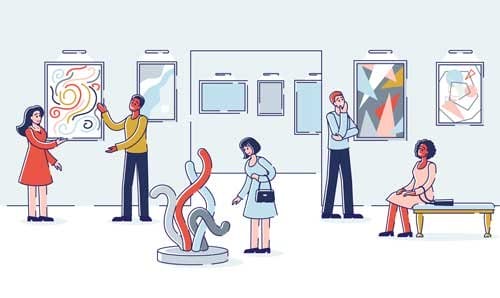In an increasingly digital world, the art scene is no exception to the transformation. Enter the online art booth, a modern twist on the traditional art fair booth accessible from anywhere worldwide. An online art booth is a virtual space where artists can showcase and sell their work, much like at a physical art fair, without the geographical limitations and high costs associated with physical venues.

In today’s evolving art landscape, the online art booth emerges as a seamless extension of your physical art fair booth. Imagine a visitor, captivated by your work at a local art fair or weekend market, yearning for a second look or a deeper connection.
With an online art booth, they can relive that immersive experience from the comfort of their homes. Leveraging cutting-edge technologies like video presentations, 360-degree imagery, chatbots, and AI-driven interactions, artists can recreate the tangible feel and personal engagement of a physical art show. It’s not just about viewing art; it’s about interacting, asking questions, and being part of an artistic journey.
By distributing business cards or flyers embedded with QR codes, artists can effortlessly guide potential patrons to their digital space. And the cherry on top? E-commerce integrations mean that admiration can instantly transform into acquisition.
For artists unfamiliar with this digital marvel, an online art booth isn’t just a platform—it’s a revolution, amplifying reach, engagement, and sales in ways previously unimagined.

What is an Online Art Booth?
An online art booth is more than just a virtual gallery; it’s an extension of your physical art space, tailored for the digital realm. Envision it as a continuation of your booth at an art fair, where visitors who were once captivated by your creations can dive back into that experience.
This dedicated platform allows you to meticulously curate your masterpieces, engage in rich interactions with art enthusiasts, and seamlessly handle sales. All this, while enjoying the ambiance of your home or studio, bridging the tactile world of art fairs with the boundless possibilities of the internet.
Elena Rodriguez: A contemporary painter, Elena embraced the online art booth platform early on. Her virtual booth, with its immersive 360-degree views, allowed global art enthusiasts to experience her vibrant landscapes as if they were in a physical gallery. The result? A threefold increase in her sales within six months.
Comparison with Physical Art Booths
Traditionally, artists have showcased their work at art fairs, galleries, and exhibitions. These physical spaces offer a tangible experience for both the artist and the viewer. Visitors can stroll through aisles of booths, feel the texture of a painting, and engage in face-to-face conversations with the artists.
How an Online Art Booth Differs from a Traditional Artist’s Website
While a traditional artist’s website serves as a portfolio and a point of contact, an online art booth is designed to replicate the experience of an art fair or gallery exhibition, but in a digital format. Here are key differences:
- Interactivity: Online art booths often feature live chat options, virtual reality (VR) walkthroughs, and interactive tools that allow visitors to engage with the art and the artist, similar to a physical art fair. These features create a dynamic and immersive experience, encouraging visitors to explore and connect with the artist in real-time, fostering a deeper connection between the artist and potential buyers.
- Event Focus: Online art booths are often part of larger virtual art fairs or exhibitions, creating a sense of event and urgency that encourages visitors to make purchases, much like they would at a physical event. This event-driven approach can generate excitement and buzz, attracting a larger and more engaged audience than a standalone website might.
- Curated Experience: An online art booth is designed to simulate the experience of walking through a physical booth at an art fair. The layout, design, and navigation are crafted to guide the visitor through a curated experience of the artist’s work. This intentional design strategy helps to tell a story through the art, allowing the artist to take visitors on a journey, much like a guided tour of a physical gallery.
- Temporary Nature: Unlike a permanent artist’s website, online art booths are often time-limited, mimicking the temporary nature of a physical art fair or exhibition. This creates a sense of urgency for potential buyers and makes each virtual event a unique and exclusive opportunity to acquire art, adding to the allure and excitement of the online art booth.
While an online art booth lacks the tactile and personal interaction of a physical space, it offers unparalleled convenience and reach, making it an increasingly popular choice for artists in the digital age.
Why Consider an Online Art Booth?
In the evolving digital landscape, an online art booth offers artists new avenues to showcase and sell their work. Let’s take a look at the reasons why an artist might gravitate toward this digital platform and the considerations to keep in mind.
Benefits of Having an Online Art Booth
Drawbacks and Challenges
Embracing the concept of an online art booth can be transformative, offering artists unparalleled opportunities for exposure and sales. However, like any venture, it’s essential to be equipped with the right knowledge and strategies to navigate its unique challenges.

Setting Up Your Online Art Booth – A Step-by-Step Guide
Embarking on the journey of creating your own online art booth can be both exciting and overwhelming. Here’s a step-by-step guide to help you navigate the process and ensure your booth stands out in the digital art world:
- Choosing a Platform:
- Research various platforms that offer online art booth services. Some popular options include Artsy, Art Basel’s Online Viewing Rooms, and Artland.
- When evaluating platforms, consider features like user-friendly interfaces, customization options, integrated payment gateways, live chat capabilities, virtual reality (VR) walkthroughs, and analytics to track visitor engagement.
- Also, assess the platform’s fees, audience reach, and customer support. A responsive support team can be invaluable when you encounter technical issues or have queries.
- If you’re tech-savvy, you might even consider building a booth on your own website using platforms like WordPress or Wix. These platforms offer extensive customization and plugins tailored for artists.
- Designing Your Booth:
- Your online booth is a reflection of your art and brand. Spend time conceptualizing a design that complements your art style and resonates with your target audience.
- For instance, if your art is vibrant and colorful, opt for a minimalist design that lets your art pop. Conversely, if your art is monochromatic or subtle, a bolder design might enhance its appeal.
- Ensure the design is mobile-responsive. With many visitors accessing your booth via smartphones or tablets, a seamless mobile experience is crucial.
- Uploading Your Art:
- High-quality images are paramount. Invest in professional photography or, if budget constraints exist, learn techniques to take clear, well-lit photos of your artwork.
- Include detailed descriptions for each piece. Beyond the medium and dimensions, share the story or inspiration behind the work, which can create a deeper connection with potential buyers.
- Consider adding multimedia elements like videos, 360-degree views, or even augmented reality previews to offer a richer, more immersive experience.
- Pricing and Selling Your Work:
- Pricing art can be subjective. Be transparent with your pricing, but also be informed. Research similar artists, consult with mentors or peers in the art community, and consider the time, materials, and effort invested in each piece.
- Offer multiple payment options to cater to a global audience. This includes credit card, PayPal, or even emerging options like cryptocurrency.
- Clearly state your shipping, insurance, and return policies. Transparency can build trust and reduce potential disputes.
- Promotion and Marketing:
- A beautiful booth with stunning art needs visibility. Utilize social media marketing to showcase your booth. Platforms like Instagram, with its visual focus, can be particularly effective.
- Collaborate with other artists, influencers, or art bloggers to increase your booth’s visibility. Joint promotions or features can introduce your work to new audiences.
- Engage with visitors proactively. Host live chats, virtual events, or webinars, offering insights into your art and creative process. This engagement can foster relationships and drive sales.
- Feedback and Iteration:
- The digital realm is dynamic. Regularly seek feedback from visitors, peers, and even art critics. This feedback can provide valuable insights into areas of improvement, be it in design, user experience, or art presentation.
- Stay updated with the latest digital trends, tools, and technologies. Continuously iterate on your booth’s design and features to enhance the user experience and stay ahead of the curve.
Setting up an online art booth requires effort, dedication, and a bit of technical know-how. But with the right approach, tools, and persistence, it can be a rewarding venture that significantly boosts your art’s visibility and sales potential.
Branding Your Online Art Booth

In the digital realm, where countless artists vie for attention, branding becomes the beacon that guides art enthusiasts to your virtual doorstep. An online art booth, while a platform to showcase your masterpieces, is also a reflection of your identity as an artist. It’s not just about displaying art; it’s about creating an immersive experience that resonates with your audience.
Understanding and effectively communicating your brand is pivotal. Your brand encapsulates your artistic philosophy, the emotions your art evokes, and the unique nuances that set your work apart. Before diving into the aesthetics of your booth, introspect on these elements. What story does your art tell? What feelings do you wish to stir in your audience? By answering these questions, you lay the foundation for a brand that’s authentic and compelling. For a deeper dive into the intricacies of branding, consider exploring this comprehensive guide on artist branding.
Marketing Your Online Art Booth

Navigating the vibrant tapestry of the digital art world requires more than just talent; it demands a strategic approach to reach art enthusiasts and collectors.
While your online art booth is a canvas showcasing your masterpieces, effective marketing paints the path for art lovers to discover and engage with your creations. Here are some tried-and-true strategies to amplify your booth’s presence:
Social Media Strategies: Platforms like Instagram, Pinterest, and Facebook are visual-centric, making them ideal for artists. Regularly post high-quality images of your art, behind-the-scenes content, and engage with your followers through comments, polls, and stories. Utilize relevant hashtags to increase discoverability. Features like Instagram’s ‘Shop’ can also be harnessed to directly link art pieces to your online booth, streamlining the buying process.
Email Marketing: An artist’s relationship with their audience is intimate and personal. Email marketing offers a direct channel to nurture this bond. Regular newsletters can keep art enthusiasts informed about new artworks, exclusive offers, or upcoming events. Personalized campaigns can deepen the connection, turning admirers into patrons. For artists looking to delve deeper into this strategy, here’s a guide on Email Marketing for Artists.
Collaborations and Partnerships: Collaborate with fellow artists, influencers, or art bloggers for joint promotions or features. Such partnerships can introduce your work to new circles and enhance your booth’s visibility. Virtual art events or webinars with other artists can also be a magnet for traffic and engagement.
With the right marketing mix, your online art booth can become a bustling digital gallery, attracting art lovers from all corners of the globe.







